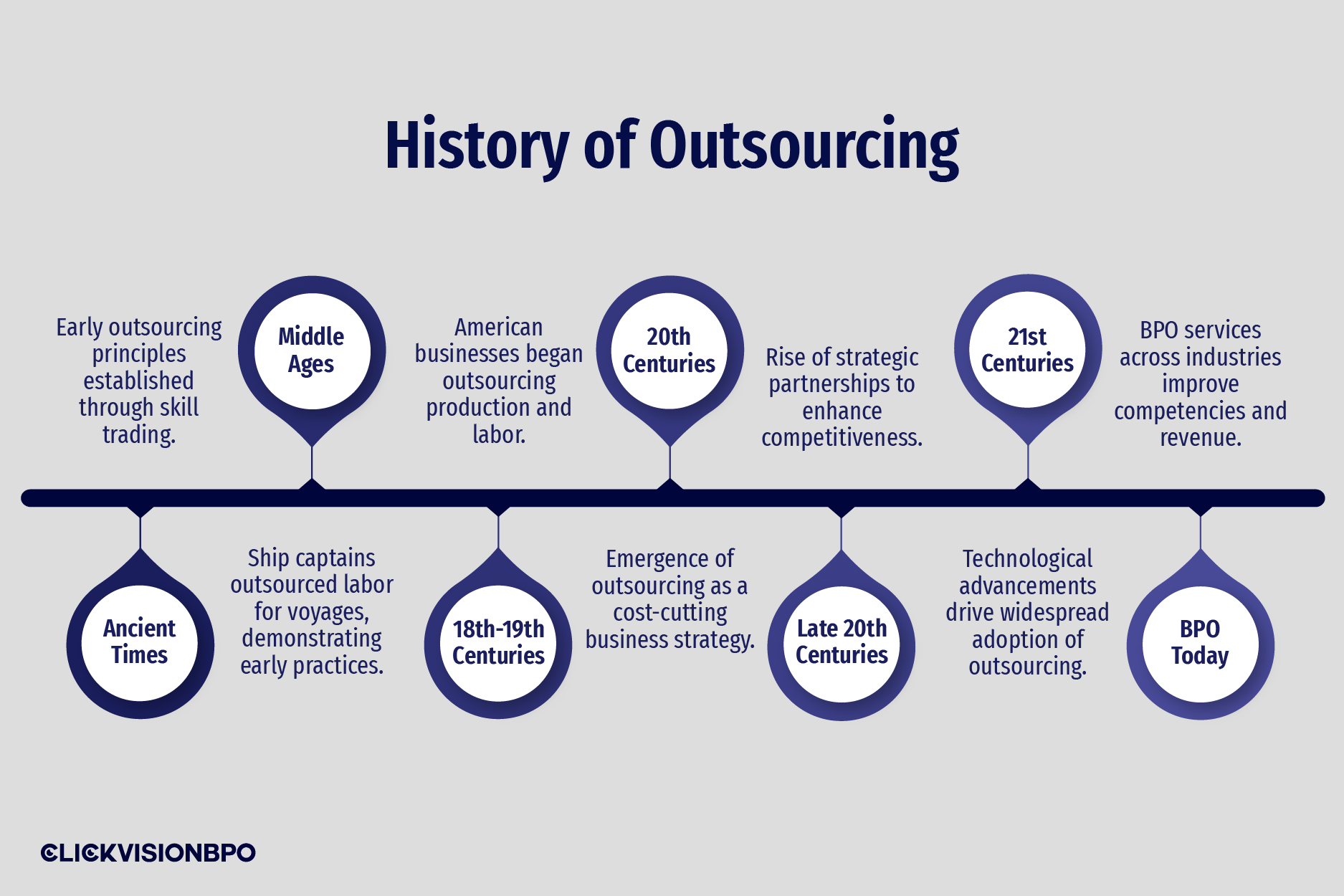We have all heard of outsourcing and its many benefits. Today, BPO (business process outsourcing) has a leading role in the global business landscape, and outsourcing to third-party partners to take care of business operations has become essential. But have you ever wondered when did outsourcing begin?
If you want to take a quick tour into the history of outsourcing, look no further than this article. Here, you can explore the evolution of outsourcing and discover the crucial points in its history.
This read will help you recognize the significance of outsourcing and understand why and how partnering with outsourcing partners such as CLICKVISION BPO can help your business grow and stay ahead of competitors.
The Origins of Outsourcing
When did outsourcing begin?
Outsourcing began in the 1970s when manufacturing companies started outsourcing to outside parties to help them manage inessential production processes.
Yet, examples of early practices related to outsourcing can be seen even in times, when people who possessed skills for something traded those skills for some kind of compensation.
Put simply, if we glimpse into the history of humankind, we can notice numerous methods linked to outsourcing, from which people benefited in various ways.
Another instance of early outsourcing can be seen in the Middle Ages when ship captains outsourced cheap ship crews from undeveloped countries. Of course, even though those practices weren’t known as outsourcing then, they worked on the same principles and had advantages similar to modern outsourcing.
Thus, we can infer that outsourcing has been present probably since the dawn of time. However, it wasn’t until the 20th century that outsourcing became an official business strategy.

Source: freepik.com / Photo Contributor: maks_lab
Outsourcing during the Industrial Revolution
In American history, outsourcing can be traced back to the 18th and 19th centuries, during the American Revolutionary War and the Industrial Revolution.
During the Revolutionary War, America lacked allies, supplies, and arms. According to history, the French became American allies who supported the American cause.
Arms, supplies, ammunition, and uniforms were obtained from the French, and they helped the Revolutionary War by giving the Americans combat troops and naval support to help fight and overthrow British Rule.
After the Revolutionary War, when the Industrial Revolution started blooming on American soil, American manufacturing businesses began to outsource various production segments, operations, and labor.
For illustration, American factories would regularly outsource raw materials from India, which were processed in Scotland. The processed materials were often sent to other outsourcing factories, which made them into products. That way, the American factories cut labor and production costs while maintaining quality and consistency.
In both cases, the benefits of early outsourcing have shown to be tremendous, and we can undoubtedly say that these early practices have set the foundations for modern outsourcing.
20th-century outsourcing
Even though outsourcing started massively emerging in the 1950s, it wasn’t until the 1970s and 1980s that outsourcing became a plausible business idea.
In the second half of the 20th century, companies became aware that if they focused on the business’s core strengths and outsourced smaller operations, they could profit and take advantage of the current economies and markets. As a result, they began to initiate resourcing and aim to expand their corporate bases and cut labor costs.
Somewhere in the late 1980s, or in 1989, to be exact, outsourcing was revolutionized, with Eastman Kodak outsourcing almost all of its IT systems. This is one of the most critical moments in outsourcing history because the business move that Kodak did influenced other major companies to spread to outsourcing partners.
Offshore outsourcing
When we ask when outsourcing began spreading internationally, we should look at the 1990s, when Asia became a valuable outsourcing market.
In particular, when advanced American companies noticed economic liberalization in Asian countries such as China, India, and the Philippines, they started offshoring their business needs.
To put it differently, companies that sought cost-effective business solutions started seeking partners further from the country’s borders. China, India, the Philippines, and several other countries offered skilled talent, an excellent business environment, and cost savings, among other things.
Additionally, telecommunication, IT, and Internet advancements enabled Asian outsourcing companies to offer high-quality services. Hence, operations such as human resources, customer services, and back-office activities were all outsourced offshore.

Source: freepik.com / Photo Contributor: Who is Danny
Strategic partnerships
During the late 1990s and beyond, the development of strategic partnerships became a trend in outsourcing. Managers became aware that owning all the technology to assess the information they need wasn’t necessary and realized that they could broaden outsourcing further back-office activities.
Thus, they focused on forming strategic partnerships with outsourcing partners, which could deliver effective results, regardless of whether the operation was a core strength or not.
The strategic outsourcing practices primarily seen in the 1990’s and early 2000’s had many benefits. They allowed companies to improve and revolutionize vital business operations while receiving cost optimization.
By partnering with outsourcing partners, companies gained access to external talent, advanced technology, and improved internal processes. Consequently, they stayed competent and competitive in a market that continued to alter.
21st century outsourcing
As already presumed, technological progress had a substantial part in the revolution of outsourcing that began to bloom when humanity entered the new millennium.
In other words, outsourcing skyrocketed in the 2000s and the following decades, and ever since it’s been widely recognized as business process outsourcing.
In the early 2000s, BPO delivered invention and functional advancement, with higher efficiency for smaller investments as one of its significant advantages. BPO partnerships resulted in increasing profits, market share growth, business transformation, and shareholder value enhancement.
Meanwhile, BPO providers have matured, pursuing solid business partners and moving beyond back-office operations quickly.
By the first decade’s end, BPO providers offered high-value and complex services, adopting new technologies and skills that made them unique and ambitious.
BPO has only grown and developed ever since, becoming one of the fastest-growing markets in the world today.
BPO today
BPO service providers today offer all kinds of services, acquiring experience and expertise in different areas of work. Moreover, BPO has penetrated every industry, including finance, healthcare, insurance, retail, tech, and more.
Financial and market research, cybersecurity operations, data processing, data analytics, and customer services are just some of the astounding capabilities of BPO companies.
Time and practice have shown that outsourcing various core operations allows businesses to improve core competencies, customer satisfaction, revenue, efficiency, and management.
With outsourcing services going digital and BPO becoming a global trend, the business world has transformed positively. Business process outsourcing has supported companies and employees in seeking innovation and optimization, influencing economic growth. Therefore, we can say that the future of outsourcing is brighter than ever.

Conclusion
In conclusion, it’s important to know when outsourcing began and how it has advanced through the years, priming into the BPO we all recognize today.
Even though we couldn’t provide you with a particular date to when did outsourcing begin or who started outsourcing, we could still guide you through the early origins of outsourcing and its primary historical examples.
Witnessing its evolution and having more profound knowledge of outsourcing practices makes outsourcing an even more compelling subject. To wrap it up, we can conclude that outsourcing has always been a crucial path for businesses striving for success, and we can’t wait to see what lies in its forthcoming fate.

With a strong background in the marketing industry and healthcare leadership roles, Filip is responsible for CLICKVISIONBPO’s sales strategies and onboarding new clients. With a passion for sharing insights gained from his experience, he also shares valuable knowledge through industry related articles.
